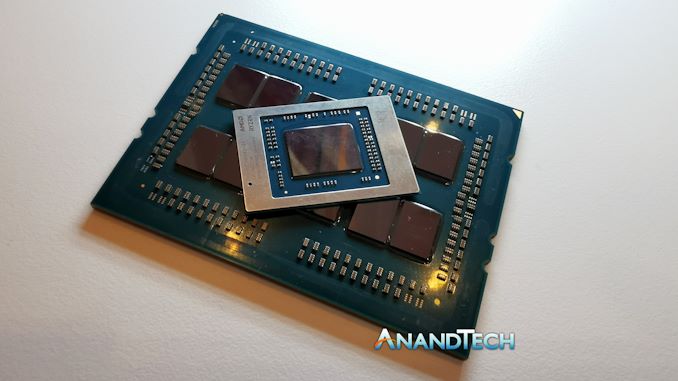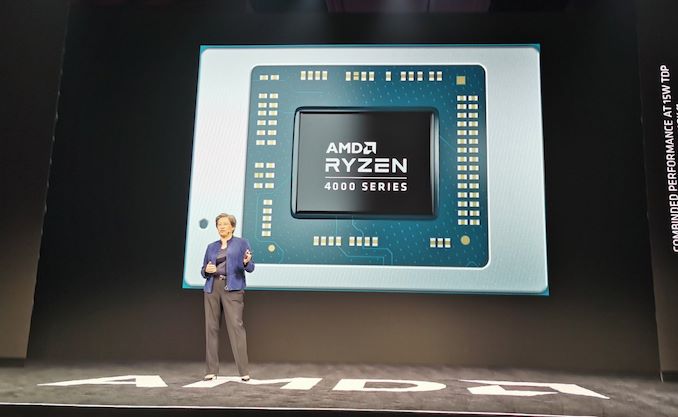AMD Ryzen Mobile 4000: Measuring Renoir’s Die Size
by Dr. Ian Cutress on January 14, 2020 9:00 AM EST- Posted in
- CPUs
- AMD
- Trade Shows
- Ryzen Mobile
- Renoir
- CES 2020
- Ryzen 4000

I’m pretty sure that the next time I go to a trade show where new silicon is being announced, the next tool I need in my backpack is a set of calipers in order to measure the die size. While die size doesn’t in of itself mean much as a number on its own, it is the end result of lots of hard work, focused co-design between silicon engineers and the semiconductor fabs, and ultimately there’s a fine balance between features, die size, performance, power, and at the end of the day, cost. With AMD showcasing the first x86-based 8-core CPU to move into the 15 W power envelope, finding out the die size is one of the elements of our investigation into how AMD has created its new Renoir / Ryzen Mobile 4000 product.
When I first saw the silicon, I wasn’t able to take pictures. Instead, I had to guess the size by manually placing it next to a 8-core Zen 2 chiplet from AMD’s monster 64-core Threadripper 3990X. We’ve known the die size for a while now, at 10.32 x 7.34 mm, or 75.75 mm2. My guess at the time that the new Renoir APU was almost exactly double the Zen 2 chiplet, and I mean it was scary how close to double the size it was. At the time of the announcement of Ryzen Mobile 4000, I had stated in our article that I estimated 150 mm2 for the die size. Turns out, I wasn’t too far wrong.
This image is not to scale.
Later at CES, I went up to the AMD booth and this time they were more than happy for me to take photographs of the new silicon. The 3990X was also there, so I could place the two side by side and get a reasonable reference photograph on which to do calculations. This is the point of the event where I should have remembered to bring calipers! Taking photographs of chips is actually quite hard, making sure you get them lined up perfectly to get the same perspective, but also having enough light to get clear defined silicon edges.
In our picture, the Renoir chiplet you may notice is very slightly angled to the camera, which we’ve compensated for in our measurements.
With that in mind, here are our numbers.
The Zen 2 chiplet on the left, measures 10.32 mm by 7.34 mm, which is a ratio of 1.406 to 1.
In our image, the chiplet measured 265 pixels by 189 pixels, which is a ratio of 1.402 to 1.
In our image, the Renoir SoC measured 282 pixels by 350 pixels, which is a ratio of 0.806 to 1.
If we take the corresponding pixel dimensions, that gives us 10.98 mm by 13.59 mm, a ratio of 0.808 to 1.
This means that the die size of an eight-core Renoir APU with eight 2nd Gen Vega compute units, according to our calculations, 149.27 mm2.
| Die Sizes | ||||||
| AnandTech | x | y | Die Size | Process | Cores | EUs/ CUs |
| AMD Zen 2 Chiplet | 10.32 | 7.34 | 75.75 mm2 | TSMC N7 | 8 | - |
| Intel Ice Lake | 11.44 | 10.71 | 122.52 mm2 | Intel 10 | 4 | 64 |
| Intel Tiger Lake | 13.64 | 10.71 | 146.10 mm2 | Intel 10+ | 4 | 96 |
| AMD Picasso | 19.21 | 10.92 | 209.78 mm2 | GF 12 | 4 | 11 |
| AMD Renoir APU | 13.59 | 10.98 | 149.22 mm2 | TSMC N7 | 8 | 8 |
That’s pretty close to my 150 mm2 estimate, and I’ve also spoken to a few trusted individuals who have been tracking Zen 2 die structure sizes and graphics structure sizes, and they came out very similar, within 1mm2 or so.
At 149.27 mm2, assuming that AMD is achieving the same defect ratio on the silicon as reported by TSMC for the standard N7 process (0.09 defects per cm2), the process yield should be around 90%. Obviously that doesn’t take into account manufacturing for yield, or the distribution of the power/frequency of the chips within a wafer, but it’s still rather impressive.
Before AMD announced this new chip, there was a good deal of speculation as to how AMD would build it: either four cores with more graphics, or with eight cores and graphics only a little better. One factor of that was the die size: at 200 mm2, one would have expected AMD to definitely use eight cores. For sub 125 mm2, in order to maintain GPU performance, perhaps a quad-core design only have been suitable. However, AMD is claiming a great win here: eight Zen 2 cores, with frequencies at 1.8-4.3 GHz at 15 W, and despite fewer graphics compute units (down from 11 to 8), a higher per-compute unit performance claim of +56% means that performance is actually higher. All just shy of 150 mm2.
We are living in the future. I can’t wait for more.
It's worth noting that AMD's official number for the Zen 2 die size is 74 mm2. This is derived from the floorplan of the chip, which during manufacturing has additional space added to ensure clean die seperation between adjacent die prints. Ultimately what we get as the consumer is that seperation lane (known as a scribe lane) from one side of the die to the other, which is just slightly bigger than the floor plan that AMD supplies to the fabrication plant / TSMC. With calipers, what we get is that additional space, which is above AMD's quoted size.












103 Comments
View All Comments
Tamz_msc - Tuesday, January 14, 2020 - link
i7 1056G7 - 1.3GHz base/3.9 GHz TurboR3 4300U - 2.7GHz base/3.7 GHz Boost
Based on these there is a distinct possibility that the all-core turbo/boost of the two chips are going to be similar. AMD's 'boost' isn't a single-core turbo - its the maximum possible frequency of a single core based on electrical and thermal headroom.
Alistair - Tuesday, January 14, 2020 - link
yeah AMD has double the clock rate vs. Intel sustained at 15w and he says "clock speeds are absolutely bad to compete with Intel"... smh...some people are just dumb (writermies is that you?)
milli - Tuesday, January 14, 2020 - link
Intel's all-core frequency is nowhere near the base frequency. Usually it's much higher.If you bash the Intel chip with AVX-512 and at the same time use the GPU, you will get the base frequency. But that's not a fair comparison since the AMD chip doesn't even have AVX-512.
iranterres - Tuesday, January 14, 2020 - link
AVX-512 does not seem to be relevant just yet, and despite AMD not clocking higher, it's better on clock-for-clock then Intel chips at the moment.Alistair - Wednesday, January 15, 2020 - link
all-core frequency isn't 15 watts, it is higher than 15 watts, base frequency is the one guaranteed at 15 wattssing_electric - Wednesday, January 15, 2020 - link
It's totally fair to compare dissimilar products as long as they're in the same market. Comparing a $25k "crossover" SUV to a $500k Ferrari isn't fair, but if two companies sell ~$25k crossovers, it's totally fair to compare them, even (especially, actually) if one has a ton of features the other lacks.Having said that, I'm not sure AVX-512 falls into that category. Sure, for some workloads - and therefore, some users - it's a huge deal, but for many more, it's not a significant driver of performance.
I'd bet that for most users, doubling the cores will have a more significant impact on overall performance, but for others, max (sustained) frequency for single-core is probably most relevant.
milli - Friday, January 17, 2020 - link
I don't understand why all you make such a huge deal out AVX-512 from my post. All I'm saying is that all-core frequency is higher than base frequency. You only hit base frequency if AVX-512 and/or GPU are used. Just for the CPU, base frequency isn't required to stay under 15W.Previous posts were comparing Intel base frequency to AMD base frequency, which isn't fair. That's all.
Korguz - Friday, January 17, 2020 - link
" Previous posts were comparing Intel base frequency to AMD base frequency, which isn't fair. " how is it not fair ??milli - Sunday, January 19, 2020 - link
Because just like Intel's and AMD's TDP are not fully comparable, the base frequencies aren't either.Korguz - Sunday, January 19, 2020 - link
ahh but it is.. if you look at the desktop cpus... most clam intel is the better cpu because it clocks higher.. but like always... now that amd is the higher clocked cpu on mobile.. its unfair ??it always seems.. if intel does it.. its ok.. but if amd does the same... its not ok.. look at power usage over the years... to now claim... its unfair.. is just an excuse from the intel fans to try to make intel look better...